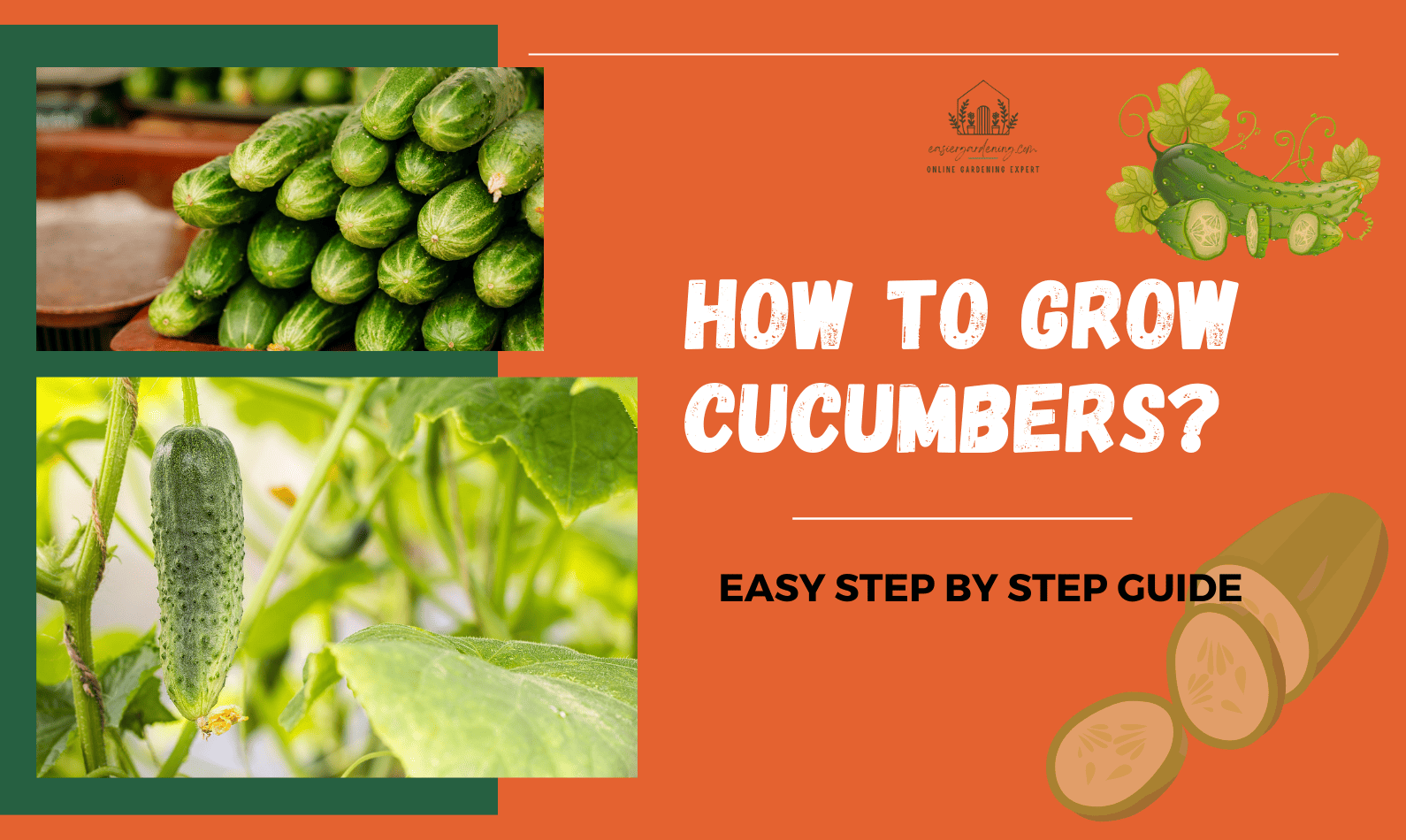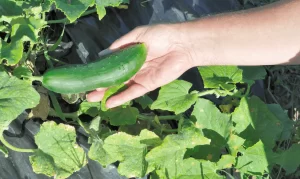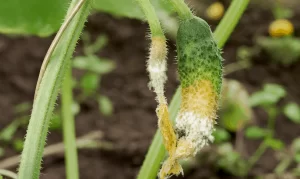How To Grow Cucumbers? Easy Techniques to Learn: Cucumbers are tender annuals that thrive in temperatures ranging from 60° to 90° F (15° to 32° C). If you think store-bought cucumbers are big, wait until you grow your own. Cucumbers can grow up to 40cm long, depending on the variety. Growing cucumbers is a lot simpler than you think, and once you get started, you’ll probably never want to stop. We clarify how to grow cucumbers and care for them in this article.
- Sow cucumber seeds or transplants in the garden three to four weeks after spring’s typical last frost date.
- Cucumbers grow best at a soil temperature of 70°F (21°C).
- Cucumber seeds can be started indoors up to six weeks before transplanting to the garden.
- Early in the season, protect cucumbers from sudden frost or chilly nighttime temperatures. Use floating row covers or plastic tunnels to keep the chill at bay.
- Cucumbers take 55 to 65 frost-free days from when they are sown to when they are harvested.
Contents
- Where To Plant Cucumbers: How To Grow Cucumbers?
- Planting And Spacing
- Growing Cucumbers In Containers
- Watering Cucumbers
- Feeding Cucumbers
- Caring For Cucumbers
- Companion Plants
- Flowering And Fruit Formation
- Cucumber Pests
- Cucumber Diseases
- I have lots of flowers on plants but no cucumbers. Why?
- Why do Cucumbers Grow and then Drop off the Plant?
- How to tell when to Harvest Cucumbers?
- Why are my Cucumbers Bitter Tasting?
- Conclusion: How To Grow Cucumbers?
Where To Plant Cucumbers: How To Grow Cucumbers?
- Cucumbers can be grown in full sun. Cucumbers can grow in partial shade.
- Cucumbers prefer soil that is loose, well-drained, and rich in organic matter. Prepare planting beds by adding 2 to 3 inches (5-7cm) of aged compost, industrial organic planting mix, and aged manure to beds before planting. Turn the soil to a depth of 12 inches (30cm).
- Cover the planting bed with black plastic sheeting to warm the soil before planting in the spring.
- Cucumbers prefer soil pH levels ranging from 5.5 to 6.8. Cucumbers can grow in alkaline soil with a pH of 7.6.
- Install trellises or supports to encourage cucumber growth, or mound the soil to create a small hill where cucumber vines can develop. Use a 4 to 6 foot (1.2-1.8m) tall trellis. Make a mound at least 16 inches (40cm) wide and several inches high, and space them 4 to 6 feet (1.2-1.8m) apart.
Planting And Spacing
- Cucumber seeds should be planted 1 inch (2.5cm) wide.
- Sow seeds at 6 to 8-inch (15-20cm) intervals at the base of the vertical support or on a mound.
- Thin seedlings to the strongest plant when they are 3 to 4 inches (7-10cm) tall, spacing them 12 to 18 inches (30-45cm) apart for vining cucumbers on vertical supports and 24 to 36 (61-91cm) apart for bush varieties.
- To avoid damaging the roots of the remaining plants, cut fragile seedlings off at soil level with scissors.
- If you grow vining varieties, put a trellis, tripod, or cage in place at planting time. A wire cage with a diameter of 12 to 18 inches (30-45cm) is suitable for growing vining cucumbers. A cage may be made out of a 4 to 5-foot (1.2-1.5m) piece of wire fencing or construction mesh.
- Cucumbers can be started indoors 2 to 3 weeks before the last frost in spring, then transplanted to the garden 2 to 3 weeks after the last frost.
Growing Cucumbers In Containers
Many dwarf or mini-cucumber varieties can grow in pots as small as 6 inches (15cm) wide and deep, but more significant is preferable. Examine the cucumber’s definition and space specifications. ‘Potluck’ is a newer cultivar. ‘Patio Pik’ and ‘Bush Whopper’ are two larger cucumbers for containers. Increase the yield of container-grown cucumbers by using a 12- to 18-inch (30-45cm) trellis, stake, or other support.
Watering Cucumbers
- Water the soil daily to keep it uniformly moist. Do not allow the soil to dry out. Cucumbers are approximately 95% water and need consistent watering for rapid, even development.
- Set up a soaker hose or drip irrigation system around the base of the plants. During the summer, give cucumbers at least 1 inch of water per week.
- Still water plants from the ground up. Moisture on cucumber leaves can lead to fungal diseases, including powdery mildew and downy mildew.
- In hot weather, leaves can wilt in the afternoon because plants absorb more water than their roots can provide.
- If plants are wilted in the morning, the soil is too dry and must be watered right away.
- Mulch around plants to prevent soil compaction caused by heavy irrigation and slow soil moisture evaporation.
- Cucumbers may become oddly shaped or bitter-tasting if they receive insufficient or inconsistent watering.
- Sticking your index finger in the soil is a convenient way to test soil moisture; if your finger comes away dry, it’s time to water.
Feeding Cucumbers
- Amend planting beds with aged compost or industrial organic planting mix until planting. Cucumbers need all of the nutrients found in compost to grow quickly.
- Every 10 to 14 days during the season, side-dress cucumbers with compost tea, a dilute solution of fish or kelp emulsion, or liquid organic fertilizer.
- Cucumbers should be fed a low nitrogen, high phosphorus, and potassium diet. Follow the label instructions carefully; over-fertilizing can stunt or damage plants.
- To replenish soil nutrients, side-dress cucumbers with aged compost in the middle of the season.
- Weeds compete for soil nutrients and water, keeping weeds out of planting beds. To prevent upsetting the roots, cultivate shallowly.
Caring For Cucumbers
Straw or chopped leaves can be used to mulch around cucumber plants. Mulch helps to preserve soil moisture while also keeping vines and fruits clean. It is difficult for slugs and snails to travel over straw or pine straw mulch.
Companion Plants
- Cucumbers go well with beans, corn, peas, pumpkins, and squash. Cucumbers should not be grown alongside potatoes or herbs.
Flowering And Fruit Formation
- Cucumber flowers have male and female flowers. Male flowers, which do not bear fruit, are the first to emerge.
- Female flowers appear about a week after male flowers. The unpollinated fruit of a female flower is a cucumber-shaped swelling at the stem end of the flower.
- When bees or other insects transport pollen from the male flower to the female flower, female flowers are pollinated. Male flowers may die and fall before female flowers emerge. Be careful or sow seeds every couple of weeks so that the garden has both male and female flowers simultaneously.
- Spritz plants with diluted sugar water to attract bees.
- If plants are in a greenhouse or hoop house where pollinating insects cannot enter, or if pollination is slow or non-existent, hand-pollinate flowers with a soft-bristled brush. A female flower will have an immature fruit on its stem, while a male flower will not.
- Pollinator plants are required for gynoecious, hybrid cucumbers, and monoecious plants with female flowers.
- Cucumber fruits hung from a trellis or vertical support can grow straight due to gravity.
- Cucumbers grown on the ground should be supported by a tile or piece of wood so that the fruit does not come into direct contact with the soil; this allows cucumbers to mature with less exposure to disease and insects.
- Cool weather, rain, and insecticides may slow or harm pollination.
Read more about How to Grow an Orange Tree from Cutting?
Cucumber Pests
- Aphids, cucumber beetles, squash bugs, and slugs may target cucumbers.
- Aphids can be managed by hosing them off with a blast of water or pinching out infested vegetation.
- Cucumber beetles feed on plant tissue and chew holes in the leaves, spreading cucumber bacterial wilt. Pick them off the vines by hand and burn them.
- Squash bugs feed on plant sap, causing the leaves to wilt. Squash bugs may also attack seedlings. Plants should be dusted with diatomaceous earth around the base.
- Slugs can scrape ragged holes in leaves. Diatomaceous earth should be applied around the base of the plants.
Cucumber Diseases
- Scab, mosaic, and mildew may all affect cucumber plants.
- Keep the garden free of debris and weeds, serving as a breeding ground for pests and disease.
- Remove diseased plants as soon as possible; place them in a paper bag and dispose of them in the garbage to prevent the spread of disease.
- Cucumber beetles spread bacterial wilt, causing plants to wilt and die just as they begin to harvest. Beetles should be dealt with as soon as they emerge.
- Cucumber leaves can turn greyish-white late in the season due to powdery mildew and downy mildew, both fungal diseases. Spraying plants with horticultural oil or neem oil may help slow the spread of fungal diseases.
- Plant tolerant varieties and space plants further apart to improve air circulation and help avoid fungal diseases.
Common Questions Regarding Growing Cucumber
I have lots of flowers on plants but no cucumbers. Why?
Flowers that do not bear fruit are most likely due to a pollination problem. Like squash and pumpkins, cucumber plants grow both male and female flowers. To grow the berries, these are usually pollinated by bees. Cucumber plants can be hand-pollinated if there aren’t enough bees. Make use of a small paintbrush or a Q-tip. To pass pollen, rub it against the male flower first, then the female. The appearance of what appears to be a tiny fruit under the flower distinguishes the female flower.
Why do Cucumbers Grow and then Drop off the Plant?
If a cucumber grows thin, malformed, and drops off, the cause is most likely a lack of pollination. A bee must make multiple trips to pollinate properly, so if pollinator activity is poor, the cucumber plants will not be wholly pollinated. Hand pollination is possible by moving pollen from male to female flowers with a small paintbrush or Q-tip. Female flowers have tiny fruit hidden under the blooms.
Read more about How to Grow Lemon Tree from a Cutting?
How to tell when to Harvest Cucumbers?
Cucumbers are growing, and you can select them at any size you want. Just bear in mind that they can become less tasty if you wait too long. Cucumber flesh is firm and green when ripe. Cucumber harvesting often depends on the form you’re growing and how they’ll be used – slicing or pickling, for example. Cucumbers for slicing should be harvested at 6 inches (15 cm), whereas pickling cucumbers should be harvested at 3-4 inches (8-10 cm.). During the height of the season, you should be picking ripe cucumbers every day or two, so keep an eye on them.
Why are my Cucumbers Bitter Tasting?
They usually remain in the leaves and roots, but they may also end up in the fruits, resulting in bitter cucumbers. It could happen for various reasons, including The plant being stressed by heat stress, drought followed by overwatering, the temperature fluctuating too much, or it may simply be that the plant is genetically predisposed to have bitter taste cucurbitacins in the fruits. Picking the fruit too late can also result in bitter cucumbers.
Learn more Why are my cucumber plants dying?
Conclusion: How To Grow Cucumbers?
Cucumbers grown at home taste delicious and can be grown in a greenhouse or in a dark, sheltered spot outside, depending on the variety. Seeds can be sown indoors or outdoors from spring to early summer, or young plants can be purchased from garden centres.




